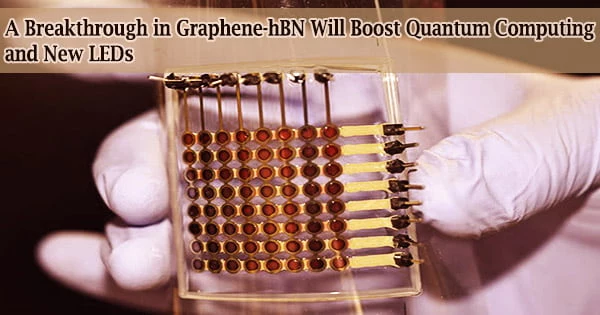A research team from the University of Michigan has discovered the first dependable, scalable technique for generating single layers of hexagonal boron nitride atop graphene, which might hasten the development of next-generation electronics and LED devices.
In a report published in Advanced Materials, the procedure is described in detail. It uses the popular molecular-beam epitaxy approach to create enormous sheets of high-quality hBN.
Deep-UV LEDs can be powered by graphene-hBN structures, which is not achievable with current LEDs, according to Zetian Mi, a professor of electrical engineering and computer science at the University of Michigan and a corresponding author of the paper. Lasers and air purifiers could benefit from the lower size and higher efficiency of deep-UV LEDs.
“The technology used to generate deep-UV light today is mercury-xenon lamps, which are hot, bulky, inefficient, and contain toxic materials,” Mi said. “If we can generate that light with LEDs, we could see an efficiency revolution in UV devices similar to what we saw when LED light bulbs replaced incandescents.”
The world’s thinnest insulator is hexagonal boron nitride, while the thinnest semimetal is graphene. Semimetals are significant because of their use in computers and other electronics because of their highly malleable electrical properties.
A wealth of unusual features are released when smooth, one-atom-thick layers of hBN and graphene are bonded together. Deep-UV LEDs could be made possible by graphene-hBN structures, as well as smaller, more effective electronics and optoelectronics, and a range of other uses.
“Researchers have known about the properties of hBN for years, but in the past, the only way to get the thin sheets needed for research was to physically exfoliate them from a larger boron nitride crystal, which is labor-intensive and only yields tiny flakes of the material,” Mi said. “Our process can grow atomic-scale-thin sheets of essentially any size, which opens a lot of exciting new research possibilities.”
Due to their extreme thinness, graphene and hBN can be used to create electronic devices that are more smaller and more energy-efficient than those that are currently on the market. Layered hBN and graphene structures can also display unexpected characteristics, such as the capacity to transition from a conductor to an insulator or sustain uncommon electron spins, that could be used to store data in quantum computing systems.
Researchers have known about the properties of hBN for years, but in the past, the only way to get the thin sheets needed for research was to physically exfoliate them from a larger boron nitride crystal, which is labor-intensive and only yields tiny flakes of the material. Our process can grow atomic-scale-thin sheets of essentially any size, which opens a lot of exciting new research possibilities.
Professor Zetian Mi
Researchers have attempted to create thin layers of hBN in the past using techniques like chemical vapor deposition and sputtering, but they have had difficulty obtaining the even, precisely ordered layers of atoms required to properly connect with the graphene layer.
“To get a useful product, you need consistent, ordered rows of hBN atoms that align with the graphene underneath, and previous efforts weren’t able to achieve that,” said Ping Wang, a postdoctoral researcher in electrical engineering and computer science. “Some of the hBN went down neatly, but many areas were disordered and randomly aligned.”
Researchers from the fields of materials science and engineering, electrical engineering and computer science, and physics have found that ordered rows of hBN atoms are more stable at high temperatures than unfavorable jagged forms.
Armed with this information, Wang started playing around with molecular-beam epitaxy, an industrial technique that essentially involves spraying individual atoms onto a substrate.
Wang sprayed individual boron and active nitrogen atoms onto a terraced graphene substrate, which is effectively an atomic-scale staircase, after heating it to about 1600 degrees Celsius. The outcome was significantly above the team’s expectations, generating perfectly organized seams of hBN on the terraced edges of the graphene that grew into broad ribbons of substance.
“Experimenting with large amounts of pristine hBN was a distant dream for many years, but this discovery changes that,” Mi said. “This is a big step toward the commercialization of 2D quantum structures.”
Without the cooperation of many other disciplines, this outcome would not have been achievable. Electrical engineering, computer science, materials science, and engineering researchers from Yale University and the University of Michigan contributed to the mathematical theory that served as the foundation for some of the work.
The method was created, the substance was created, and the material’s interactions with light were studied in Mi’s lab. Then, Ohio State University partners and material scientists and engineers from the University of Michigan carefully examined its electrical and structural characteristics.
Emmanouil Kioupakis, associate professor of materials science and engineering at U-M, and Jay Gupta, professor of physics at OSU, are also corresponding authors of the paper. The research was supported by the Michigan Engineering Blue Sky Initiative, Army Research Office, National Science Foundation, U.S. Department of Energy, and the W.M. Keck Foundation.





